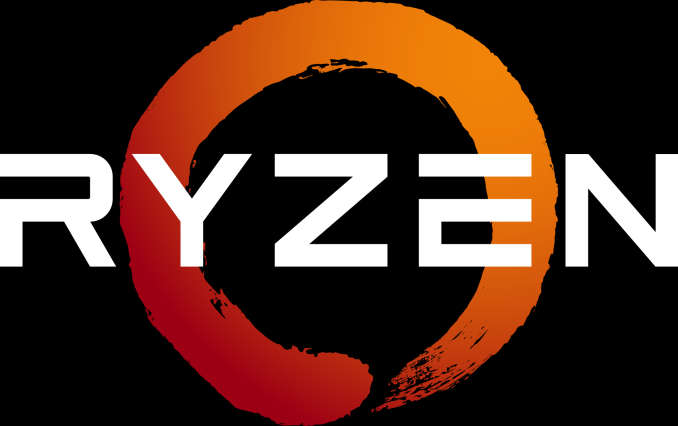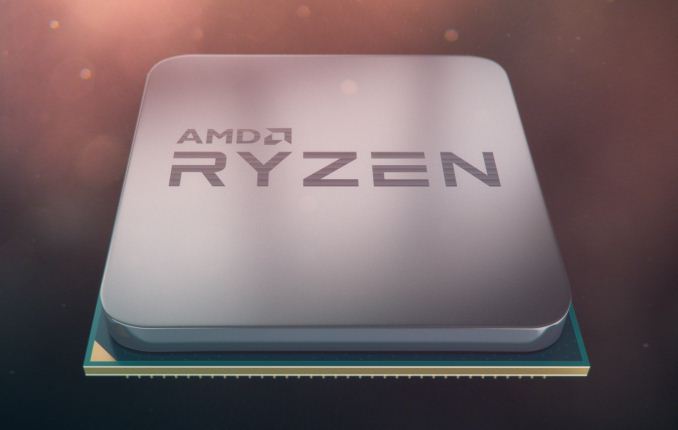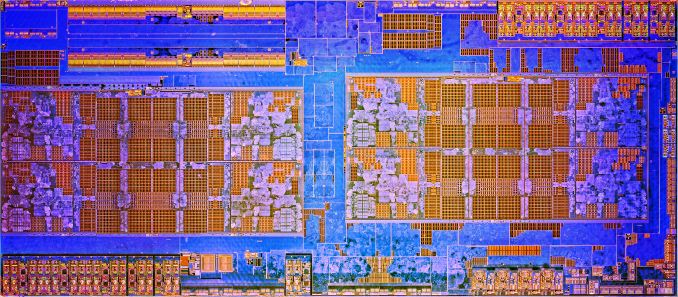AMD Launches Ryzen: 52% More IPC, Eight Cores for Under $330, Pre-order Today, On Sale March 2nd
by Ian Cutress on February 22, 2017 9:00 AM EST
The biggest x86 launch for AMD in five years is today: Ryzen is here. As always before a major launch, AMD gives a ‘Tech Day’ for relevant press and analysts, and through this event AMD’s CEO, Dr. Lisa Su lifted the lid on one of the most anticipated products in the semiconductor industry. AMD knows how to control the level of enthusiasm for its fans, and today is the end result, with processors going on pre-order from major retailers today at 1pm EST, ready for a general hard launch on March 2nd.
In a similar vein to launches of recent smartphones, AMD is doing a staggered announcement/launch with the products on their new microarchitecture. Where Samsung/Apple might give all the details for a product a few weeks before it’s available to buy, today on February 22nd marks the day where AMD is giving consumers information about Ryzen, and specifically the Ryzen 7 family of eight-core products. All the information today is from AMD, and AMD’s internal testing, and pre-orders also start from today for users ready to put down their money for a launch day part. Reviews of the CPUs, as well as when the CPUs will ship to customers, is on March 2nd. This also happens to be right in the middle of two annual shows, Game Developer Conference (GDC) and Mobile World Congress (MWC), making the time between receiving pre-launch samples and being able to provide independent verification of AMD’s performance claims relatively frantic. We’ll do our best!
The Ryzen Family
With a new processor launch, naming the parts and positioning them within the market is critical. So with Ryzen, the processor stack will be split into three based on performance and price: Ryzen 7 at the high end, Ryzen 5 in the middle, and Ryzen 3 for more price-conscious consumers. Both Ryzen 5 and Ryzen 3 are set to be launched later, and Ryzen 7 is the first portion of the family to be released.
Ryzen 7 will have three CPUs to start, all having eight cores and supporting simultaneous multi-threading:
- Ryzen 7 1800X: 8C/16T, 3.6 GHz base, 4.0 GHz turbo, 95W, $499
- Ryzen 7 1700X: 8C/16T, 3.4 GHz base, 3.8 GHz turbo, 95W, $399
- Ryzen 7 1700: 8C/16T, 3.0 GHz base, 3.7 GHz turbo, $329
Ryzen 7 1800X will be the high-end part, featuring a base clock of 3.6 GHz and a turbo of 4.0 GHz, within a TDP of 95W, and for $499. Next to this is Ryzen 7 1700X, launching at $399, with a base/turbo of 3.4/3.8 GHz. The final part for the launch is the Ryzen 7 1700, providing eight cores and sixteen threads for $329 at 3.0/3.7 GHz frequencies.
Processors will initially be available for pre-order from 185 retailers and OEMs worldwide, either as individual parts or pre-built systems.
What, not 40% IPC? 52% IPC??
Enthusiasts and analysts use the term IPC, or ‘Instructions Per Clock’, as a measure of how much the underlying microarchitecture improves from generation to generation. Two decades ago, a good design on a smaller node could net a healthy double-digit gain, whereas in recent years 5-10% gain has become the norm. When AMD initially announced that the new Zen microarchitecture they were developing was aiming for a 40% IPC gain, despite the low IPC they were starting from, users remained skeptical. AMD rehired Jim Keller to work alongside long-term AMD architect Mike Clark and produce a team with several goals in mind: high-performance x86, simultaneous multithreading, and a product to be relevant in the computing, PC, server and mobile space again. So despite this, 40% IPC always seemed a somewhat lofty goal, because Bulldozer was so underwhelming, and despite this low starting point. For the Ryzen launch today, AMD is stating that the final result of that goal is a 52% gain in IPC.
This is something we will need to test in due course!
The Ryzen Silicon, and the Future
AMD pointed out that the new 8-core silicon design runs 4.8 billion transistors and features 200m of wiring. Through previous announcements we’ve examined parts of the microarchitecture including cache sizes, threading, front-end/back-end design, and so on.
AMD Zen Microarchiture Part 2: Extracting Instruction-Level Parallelism
AMD Gives More Zen Details: Ryzen, 3.4 GHz+, NVMe, Neural Net Prediction, & 25 MHz Boost Steps
AMD’s CEO was keen to point out that this is a from-scratch design for AMD, using the knowledge gained from features developed for previous products but ultimately under the hood it looks like ‘a typical x86 high-performance core’, with AMD-specific features and tweaks. We were told that AMD’s roadmap extends into the multi-year range, so while the focus for 2017 will be on this family of products, back at HQ the next two generations are in various stages of development.
BENCHMARKS PLEASE
So despite the 82+ motherboards going to be available, 19 initial PC system builders moving into 200+ through the first half of 2017, the big question on everyone’s lips is how exactly does it perform?
Well, AMD gave us the following numbers:
AMD's benchmarks showed that the top Ryzen 7 1800X, compared to the 8-core Intel Core i7-6900K, both at out-of-the-box frequencies, gives an identical score on the single threaded test and a +9% in the multi-threaded test. AMD put this down to the way their multi-threading works over the Intel design. Also, the fact that the 1800X is half of the price of the i7-6900K.
In a similar vein, again with the Cinebench 15 multi-threaded test, the Ryzen 7 1700X scores over and above the Core i7-6800K (its price competition) and higher than the Core i7-6900K which costs 2.5 times as much.
We’ll tell you what our benchmarks say, with official retail processors. But you will have to wait until March 2nd. Sorry.





















386 Comments
View All Comments
zodiacfml - Wednesday, February 22, 2017 - link
Not really. I think the price AMD has set is just right. If it does perform similarly or close to Intel, AMD can ask a bit higher and still leave a huge price difference.We have to wait for the reviews for a proper assessment and not just leaks/hypes available right now. I am certain the AMD is a bargain for multi-threaded workloads
fanofanand - Thursday, February 23, 2017 - link
There is always a premium for slightly better performance, with rare exceptions. This might be a terrible analogy but with the Camaro for instance, the standard v8 already provides a huge amount of power, but you can improve performance by a couple tenths by paying for the even higher end engine, which costs a boatload more. Some people are willing to pay 30-50% more for a 10-15% increase, I don't see why this would be any different.nikon133 - Wednesday, February 22, 2017 - link
I can see this in my next rig. Current Haswel i7 is performing well, and Intel parts released after it just haven't motivated me to upgrade, considering cost for gained performance... but this, if marketing is close to truth, this is motivating.Also... in a few years time, I can see Ryzen as very sweet foundation for next-gen consoles APU. Compatibility with Jaguar, vast performance boost on CPU side... throw in good GPU, and it would be quite respectable piece of hardware.
fanofanand - Thursday, February 23, 2017 - link
The next PlayStation should theoretically be more powerful than today's 8 core rigs with a 1080. That's just the way progress marches on.CaedenV - Wednesday, February 22, 2017 - link
Still skeptical... but this is what I was hoping for. Something that can come close to Intel's raw performance, while offering a much lower price. I am sure they will not beat out Intel on anything other than these few cherry-picked benchmarks... but honestly they don't have to.I am still rocking my now 6 year old i7 2600, and the reason I have not upgraded is because the only way 'up' is to get a vastly more expensive 6-8 core i7, and an insanely expensive motherboard to go with it. And while I would like to have that, I know I cannot justify spending that kind of money. If I can buy a mobo, cpu, and RAM for ~$800 or less that can offer similar single-thread performance, while giving the option for far more threads (and threads that don't need to be flagged specifically for HT tech) then it would be a much easier purchase decision.
Michael Bay - Wednesday, February 22, 2017 - link
>amd marketing slidesYeah, no. Hopefully Anand provides actual testing this century!
BrokenCrayons - Thursday, February 23, 2017 - link
Timely CPU reviews haven't been problematic for Anandtech to publish. Ian's always done a good job getting big meaty reviews done. It's those pesky GPU reviews that need a little help (GTX 1050, RX 460, RX 470) and those aren't Ian's domain.fanofanand - Thursday, February 23, 2017 - link
Considering this is the biggest (in terms of market disruption) CPU release in 5+ years, I have no doubt Ian has had many sleepless nights to have this all done. His Twitter feed suggested his introduction to the article was 1600 words long. Those whining about slow article time frames (I am guilty of this as well) should be pleasantly surprised by Ian's analysis which I have no doubt will be second to none.Pilotter - Wednesday, February 22, 2017 - link
Just saw youtube Austin Evans:1800x oced to 5.2g on 8 cores!!!
Here take my $499, AMD.
tarqsharq - Wednesday, February 22, 2017 - link
Well, keep in mind I think that was LN2.Not superb OC. I myself got the 1800X just because... but I won't expect base OC to get past 4.0ghz + boost.